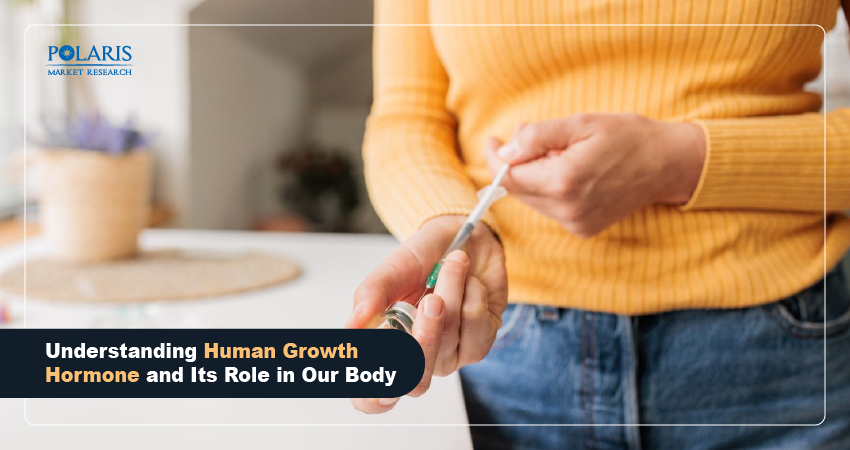How Human Growth Hormone Powers Your Body's Critical Functions

Growth hormones are essential for growth in childhood. They help in maintaining organs and tissues throughout life. The production of growth hormones gradually decreases after puberty. This natural slowdown has led to increased interest in the use of lab-made hormones to treat aging.
Curious to know more about human growth hormones and their specific function? This blog post covers it all. The major metrics for the U.S. human growth hormone market and how artificial intelligence (AI) is shaping the market landscape have also been covered. Stick with us!
What Is Human Growth Hormone?
Human growth hormone is also known as somatotropin. It is produced by the pituitary gland. The pituitary gland is about the size of a pea and can be found at the base of the brain. There are two parts of the pituitary gland. These include a back (posterior) and a front (anterior) lobe. The frontal lobe is responsible for the production of human growth hormone.
How Is Human Growth Hormone Triggered?
The release of human growth hormone is carried out by the pituitary gland in short pulses throughout the day. There are two hormones responsible for controlling the release of human growth hormone. The growth hormone-releasing hormone (GHRH) stimulates the release. Somatostatin prevents the release.
There are several other endocrine hormones responsible for regulating human growth hormone. These include insulin-like growth factor 1 (IGF-1) and glucocorticoids. The former suppresses production, whereas the latter stimulates release.
One of the best-characterized effects of human growth hormone activity is the release of IGF-1 by the liver. IGF-1 is important for preventing release. It does that through a negative feedback loop that stimulates somatostatin. However, the secretion of IGF-1 and human growth hormone is controlled by each other. Healthy individuals experience the inhibition of the hormone by hyperglycemia. Hypoglycemia, sleep, and exercise stimulate it.
What’s Driving Human Growth Hormone Demand in the U.S.?
We’ve done a detailed analysis of the U.S. human growth hormone market. The market for human growth hormone stood at USD 2.05 billion in 2024. It is projected to grow at a CAGR of 7.8% between 2025 and 2034.
High access to pediatric and adult healthcare in the U.S. allows for the early detection of growth hormone deficiencies. This, in turn, drives the growth of the U.S. human growth hormone market. The market also benefits from the strong insurance and reimbursement support in the country.
What Is the Function of Human Growth Hormone?
There are two main functions of the human growth hormone. It stimulates growth and impacts how the food consumed is converted into energy. Below is a more detailed explanation:
Growth
Growth is triggered by the human growth hormone in almost every organ and tissue in the body. However, it’s widely known for the growth effect it has on the bone and cartilage. Cells in bones and cells in cartilage receive signals from the hormone to increase replication. This enables the growth in their size. The increase in height stops after the fusing of the growth plates in the child’s bones. Then the hormone helps ensure that the normal body structure is maintained for the rest of one's life.
Metabolism
Metabolism includes chemical reactions that change the food consumed into energy. Cells in the body require energy for proper functioning. There are various complex processes involved in metabolism. The metabolic testing market involves various products that help analyze the metabolic activity.
The way human growth hormone impacts cell metabolism is by increasing IGF-1 production and its effects on body cells. The structure of IGF-1 shares similarities with insulin and manages the effect of growth hormone on the body. Insulin is an essential hormone produced by the pancreas that helps with the regulation of blood sugar levels by reducing them. As with insulin, IGF-1 has glucose-lowering effects.
What Are Normal Human Growth Hormone Levels?
The release of the human growth hormone is carried out by the pituitary gland in pulses. The duration and size of the pulse vary based on the time of day, sex, and age. As such, randomly measuring the levels of the hormone isn’t that helpful for healthcare providers to confirm or rule out a diagnosis. Instead, measurement tests for human growth hormone are most useful when they are done as part of the suppression or stimulation test.
The normal range of human growth hormone levels includes:
- Adult males: 0.4 to 10 nanograms per milliliter (ng/mL)
- Adult females: 1 to 14 ng/mL
- Children: 10 to 50 ng/mL
The range of these normal values can vary from one lab to another. So, it’s important to reference the range on the lab report when analyzing the results.
How AI Is Changing the U.S. Human Growth Hormone Market?
AI is changing the healthcare sector for the better. Solutions from the AI in the healthcare market are capable of analyzing medical data for early and more accurate detection of growth hormone deficiencies. This helps in improving patient diagnosis. AI can create personalized treatment plans. This improved the accuracy of doses and the outcomes for patients. AI enables the discovery of new drugs and accelerates the creation of new formulations. Monitoring tools powered by AI can track the adherence of patients and their response to treatments in real time.
Conclusion
Human growth hormone regulates metabolism and growth. Natural ways for boosting the hormone may include exercise and getting enough sleep. However, more research is needed for the same. Individuals in need can get synthetic human growth hormone by prescription. Synthetic growth hormone is typically used for treating conditions such as muscle-wasting diseases in adults and short stature in children. As healthcare providers seek to improve patient convenience and reduce the frequency of injections, the U.S. human growth hormone market demand is expected to rise.

